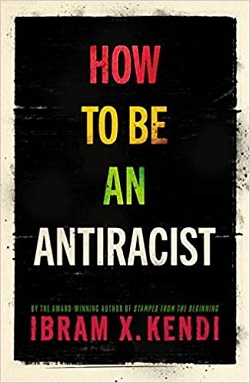How To Be An Antiracist
by Ibram X. Kendi

Do Black lives matter? It’s a simple question. Yes or no?
Either Black lives DO matter, in which case, saying yes should be easy. Or regardless of your intent or belief most people asking will hear your answer as No, Black lives DON’T matter.
On this question, there is no middle ground, no neutral. That’s the premise of Ibram X. Kendi’s book-of-the-moment, How To Be An Antiracist. Professor Kendi, director of the Center for Antiracist Research at Boston University, arguesacross a sweeping review of racist policies and ideas that the option not racist is not a thing.
As inflammatory as this might sound, the argument resonates with me. I heard the same thing 30 years ago as a grad student in South Africa. I was told time and again by people from across the social and political spectrum that whetherI liked it or not, I could never be neutral. Either I was actively working to end apartheid, or my participation in society was helping it survive. That’s the basic idea behind Kendi’s book, too.
Part treatise, part polemic, and part memoir, the book covers ground I never saw growing up in a lily-white Midwestern suburb. Now, I’m a 50-something male WASP writing on a subject I know little about. The book arguably written for someonelike me challenges the reader to think and learn, assures them they’ll fail, and promises that is okay as long as they keep working at it.
Kendi defines racism as the blend of policies, practices, and ideas that produces and normalizes [or sustains] racial inequities when two or more racial groups are not on approximately equal footing. He defines antiracismas any effort to change this or redress the inequities that racism causes and maintains. Simple, clear, uncompromising definitions that might offend some readers because they leave no gray area.
That’s why answering yes matters. In Kendi’s construct, anything else endorses unfair treatment and unequal outcomes for different racial groups. To be an antiracist, one must actively work to reverse inequities and all the elementsof society’s structure including written policies, unwritten practices, and embedded biases that support inequality. Kendi argues that tolerance or acceptance of any of this is racism.
Dig into the book and you’ll find even more contentious assertions. Society categorizes people by race, sex, and ethnicity, but these are artificial constructs, a mirage that doesn’t excuse bad individual behavior or justifyobservable inequity. As a result, Kendi contends the only possible explanation for inequality of standing, influence, opportunity, or outcome among different groups is intention: the system of racist and other discriminatory policiesexists to create, protect, and increase our society’s inequitable distribution of wealth and power for the benefit of those at the top.
Following this through to its rational conclusion, the idea of a color-blind society is a post-racial myth that if we stop identifying by race, then racism will miraculously go away. According to Kendi, those who support this ideado not realize that then we will not be able to identify racial inequity, correct it, or change the underlying policies and practices that produce or sustain it.
Ultimately, it’s these perception-stretching ideas that make this book important for our industry. Credit unions are supposed to be the anti-discrimination activists of the financial services world. The industry was created to redress policies andideas that justified denying people access to banking products and services. We were the solution. The problems vividly documented here are a reminder that our work is not yet done.
Kendi wrote this book while fighting Stage 4 cancer. It’s an unusual yet compelling combination of quasi-Christian religious tract and rage against the dying of the light, both angry and redeeming. And perhaps that’s a good description ofthe author’s persona as well. In his world, it’s not just about the police, the rich, government, or any other villains we might conceive of. We’re all sinners, all guilty, and all capable of redemption if we confess the error ofour ways and repent.
How To Be An Antiracist is challenging, provocative, and perfectly timed. It will make you think about things differently.
Chris Howard, Senior Vice President, Callahan & Associates
This article appeared originally in Credit Union Strategy & Performance.Read More Today
